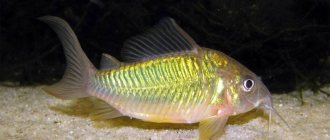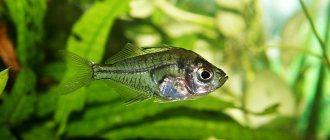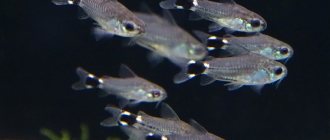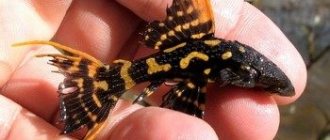general characteristics
The double-whiskered Indian glass catfish is often called a ghost. Looking at the fish for the first time, you can understand where this name comes from. The body of the fish looks transparent, it seems that the ridge and bones were filled with glass and lowered under water.
The Latin name Kryptopterus also lifts the veil of mystery: “cryptos” is translated as hidden, and “pterus” means fin. The fish have been in the collections of aquarists for a long time; the first specimens were brought from Southeast Asia even before the start of the Second World War in 1934, but glass catfish still remain poorly studied.
Ghost catfish are distinguished by a transparent, elongated body, flattened on the sides. The length of the fish reaches 10-15 cm, but it is not possible to raise individuals longer than 8 cm in captivity. The upper jaw is decorated with long mustaches, the presence of which is typical for representatives of the Somidae family.
The dorsal fin is small in size, located immediately behind the head and pressed against the body, which creates the illusion of its absence. The anal fin is transparent and extends from head to tail. The forked tail fin also appears glassy.
Lack of pigmentation of the scales and body leads to the fact that the fish appears transparent as glass. This transparency allows you to see not only the spine, but also all the internal organs of the catfish. By playing with the lighting of the aquarium, you can achieve an iridescent metallic sheen from the fish, but at the same time they still appear transparent.
The difference between females is their larger body size. Before puberty, it is impossible to distinguish males from females. Therefore, there is no point in purchasing a couple of fry; it is better to buy a dozen at once, as this increases the likelihood of having different-sex individuals.
Notes
Over the past few decades, the aquarium glass catfish has generally been referred to as Kryptopterus bicirrhis in the scientific literature, but a new paper published in the journal Zootaxa (2013) by Drs Ng Heok H. and Maurice Kottelat reveals that this popular species has, in fact, been called /misidentified for over eighty years.
This species, Kryptopterus bicirrhis, is rare in the aquarium trade. These two (authors) say that K. bichirris does not have a transparent body. This fish grows much larger (up to 245 mm). It is possible that at some point during the last 30 years or so, C. bicirrhis was a fish imported for trade, like Glass Catfish.
Now the same Glass Catfish that ends up in our aquariums under the name Kryptopterus bicirrhis has an official scientific name - Kryptopterus vitreolus. Its specific name is derived from the Latin vitreus, meaning "glass".
Arrangement of the aquarium
Since catfish is a schooling species, it is recommended to purchase at least 10-20 pieces. The volume of the aquarium depends on several factors:
- the number and size of fish that will inhabit it;
- the size of the room where the aquarium is planned to be installed;
- maintenance capabilities;
- financial opportunities.
The number of glass catfish in the aquarium must be at least 6 individuals, otherwise the fish will feel uncomfortable and begin to die one after another.
For this number of fish, a 150 liter container with dimensions (length x width x height) of at least 100 x 40 x 40 cm is sufficient.
In order for the fish to feel good, it is necessary to recreate conditions for them that resemble natural ones. Recommendations from experienced aquarists will help you properly plan your home pond for catfish and other inhabitants:
- The shape of the aquarium should be rectangular or square, preferably an elongated rectangle.
- Catfish naturally live in darkened areas of rivers, so floating plants can be planted on the surface of the water in the aquarium, which will diffuse bright daylight.
- Algae is also planted at the bottom of the aquarium; the fish will willingly hide in the thickets.
- In nature, catfish live in rivers, so it is necessary to create water circulation in the aquarium.
- Glass catfish live in the middle layers of the reservoir; they do not hide in the ground or holes, but decorations and a mound of pebbles at the bottom will not hurt.
Diseases
Since the glass catfish has a weak immune system, it often suffers from various infectious and bacterial diseases. An infectious disease can be easily identified by cloudy spots and stains that appear on the body. At the same time, behavior also changes - the fish becomes lethargic, passive, and loss of appetite is noticeable. If a disease is detected, the fish are placed in a quarantine aquarium and treatment begins. Treatment is carried out with antibiotics, which can be prescribed by a veterinarian or a person who has been keeping fish in a home aquarium for a long time. Metrogyl and lincomycin usually help with such diseases. But the best disease prevention is proper keeping of fish, where aquarium water is created in compliance with all necessary parameters.
Water benchmarks
Catfish are sensitive to water parameters, so certain parameters should be maintained:
- The acidity of the water should be between 6.5–7.5.
- Water hardness should not exceed 12-15 dH, but softer water (5-6 dH) is preferable for fish.
- Comfortable temperature in the aquarium is +23-26°C. Temperature fluctuations negatively affect the health of fish. Significant cooling of the water can lead to the death of fish. If the room is cool, a special heater equipped with a temperature sensor allows you to heat the water.
- A flow reminiscent of the movement of water in a river can be created using a compressor.
Correct conditions of detention
Glass catfish are not a problem fish. It does not require special conditions, but still some points are worth considering. A comfortable temperature range for it is considered to be from 23 ºC to 26 ºC, but for some time it can survive at high summer temperatures of up to 30ºC. The Indian catfish is not picky about the chemical composition of the water; it is enough just to maintain its standard characteristics (dH 6-12°, pH 5.7-7.2) and change one-fifth once a week.
As for lighting, the glass catfish loves diffused rays. This is worth paying special attention to: choose a lot of dense plants, including floating ones, so that the light becomes more subdued. You also need to look for several snags and decorations for the aquarium at once, because this aquarium fish loves to hide in shelters. The owners of this resident should pay attention to such important points as aeration and filtration. The air flow will create a current in the aquarium, which will imitate the natural habitat of these beauties.
Choice of neighbors
Glass catfish are not pugnacious fish. They are able to peacefully coexist with many species of aquarium inhabitants. You can choose the following as trustworthy neighbors:
- neon;
- small cichlids;
- guppy;
- swordtails;
- minors
If possible, it is best to keep glass fish in a separate aquarium, which will belong only to them. No matter how peaceful the neighbors turn out to be, the catfish live more freely with their flock.
Compatibility
Excellent for a community aquarium, they do not touch anyone except the fry that will be hunted.
They look good in a flock with cuneiform rasbora, red neon, rhodostomus or small gourami, such as honey. Among cichlids, it gets along well with the Ramirezi apistogram, and among catfish, with the changeling catfish.
Of course, you need to avoid large and aggressive fish, keep them with peaceful ones of similar size.
Difficulties of breeding
Ghostfish are difficult to breed in captivity. To obtain offspring, it is necessary to create favorable conditions, but this will not guarantee the appearance of fry. The female is capable of laying from 150 to 250 eggs, which immediately sink to the bottom. Under natural conditions, reproduction occurs at low water temperatures caused by the rainy season.
At home, for reproduction, it is necessary to reduce the water temperature in the aquarium to +23°C.
In addition, approximately ½ of the water is poured out of the container and a little softer water is added daily. Females lay eggs with good nutrition, so to stimulate the process, the fish begin to be fed with live worms. If the female has laid eggs, it is better to remove the adults from the aquarium for a while.
If the aquarium is warm (at least +28°C), then after about five days the larvae will already be actively swimming in the water column. During the first two weeks, catfish fry stay near the bottom. Encapsulated brine shrimp are used as food for babies.
Feeding
In nature, the glass catfish leads a predominantly predatory lifestyle, eating small invertebrates and zooplankton.
In captivity, it actively eats live food:
- tubifex,
- bloodworm,
- Artemia.
Over time, glass catfish can be accustomed to defrosted food or dry food.
It is important to remember that shy fish rarely rise to the surface, and it is necessary to give them sinking food, while simultaneously distracting their agile neighbors with food near the surface.
Selecting a heater and thermometer
In order not to lose the inhabitants of the underwater world too often, the aquarium is equipped with the necessary sensors and devices. A water heater is one of the essential items for fish. Most aquarium inhabitants are heat-loving, so they react negatively to a sharp drop in temperature. No matter how warm the room is in winter, the water in the aquarium will still not be warm enough.
The readings of the thermometer can be influenced by lighting lamps, so the thermometer is placed in the middle layers, on the wall opposite the heater. Thermometers that have a weighted tip and are placed vertically in the water are considered convenient. If the aquarium is large, measuring the water with a floating thermometer will be problematic. The water at the bottom is always colder than at the surface.
The choice of thermometers for an aquarium is very large, but each thermometer has certain disadvantages:
- Mercury temperature meters are highly accurate, but their use in an aquarium can result in tragedy. If the mercury tube accidentally breaks, the inhabitants of the aquarium cannot be saved. In addition, you will have to throw away all vegetation and decorations.
- Electronic instruments are the best choice when assessing the quality of measurements. The error of such devices is minimal, but the price is unreasonably high, so not everyone can afford an electronic thermometer for an aquarium. Some electronic temperature meters are equipped with sensors that sound an alarm if the temperature in the aquarium has dropped or risen to critical levels.
- Liquid crystal thermometers are glued to the outside of the aquarium. These meters are represented by a strip on which a color scale is applied. It is impossible to say that these devices are accurate, but they are in demand among consumers because they are easy to maintain. It should be noted that the thicker the glass of the vessel, the greater the error of the device. It shows the temperature of the outer glass, but cannot measure the temperature in the water column.
- An alcohol-based device provides more accurate readings than a liquid crystal thermometer. The only negative is that the quality of measurements deteriorates over time, and the indicators on the scale cannot be trusted.
When choosing a thermometer, you should pay attention not only to its beauty and price, but also to other indicators. For example, a bar showing temperature must be bright, otherwise it will be very difficult to see the exact indicators.
Buying an aquarium heater is necessary because:
- in winter, the water in the aquarium becomes too low, which is fraught with disease and death of fish;
- differences in day and night temperatures in the autumn-spring period negatively affect the health of fish;
- the water is always colder than the air in the room, so it is very difficult to heat the aquarium to the required temperature without a heater.
Modern aquarium heaters have a useful function - maintaining a set temperature and controlling it. That is, it is enough to set the required indicator on the heater so that the device warms up the water and turns off for a while. As soon as the water begins to cool, the heater turns on again.
There are two types of heaters:
- mechanical - they have a reasonable price, but insufficiently accurate indicators;
- electronic ones are too expensive and short-lived, but they accurately measure temperature.
Temperature regulators are most often produced without a built-in thermometer. They measure the temperature, but a person has no way to control the heating of the liquid. Therefore, you can’t do without buying a thermometer.
When purchasing a heater, pay attention to the following characteristics:
- power;
- the presence of a thermostat and a built-in thermometer.
If the aquarium is large, you should not choose one powerful heater. It will heat the water unevenly.
To warm up the entire perimeter of the aquarium, it is better to purchase several heaters with lower power. They will create a comfortable environment throughout the entire aquarium.
The glass catfish is a sensitive aquarium fish, so it requires a number of specific conditions for keeping in order to please the eyes of its owners for a long time.
Corridors
Representatives of the family of armored catfish, the genus Corydoras - aquarium catfish, the species of which can often be found in artificial reservoirs, have a beautiful color and calm character. The most striking representative is considered to be the speckled corydoras (Corydoras paleatus).
For these fish you will need:
• optimum water temperature – 24-25 °C; • pH – from 6.0 to 7.0; • dH - up to 4°.
The sizes of catfish are relatively small (up to 7 cm in length). Life expectancy is on average 8 to 10 years. Some specimens live up to 15 years.
They prefer aquariums with sandy soil. The bottom should be equipped with stones, driftwood and caves for fish to rest.
Speckled aquarium catfish live in schools. Due to their calm, peaceful disposition, they are compatible with almost any type of fish (except for Labeo, Botia modestus, Ancistrus). Catfish are not picky when it comes to food and will consume any food. The main thing is to use them in the form of tablets that fall to the bottom of the aquarium, since corydoras cannot grab food from the surface.
Salt solutions cannot be used to treat individuals of the genus Corydoras due to the fish’s intolerance to them.
Corydoras reproduce in pairs. The male and female are placed in a spawning aquarium, the water temperature in which is reduced to 18 °C. After laying, the female is returned back. The male is left to care for the offspring. The larvae appear after about 5-6 days. The fry feed on small plankton and crushed live food.
Representatives: Corydoras elegans (elegant catfish), Corydoras paleatus (speckled catfish), Corydoras leopardus (leopard catfish), Corydoras schultzei (golden catfish), Corydoras hastatus (dwarf catfish).
Photo of glass catfish
Flathead, or fractocephalus
There are aquarium catfish, species of which are rare in artificially created aquatic environments. These include the flathead catfish (Phractocephalus hemioliopterus), from the genus Phractocephalus, the family of flathead catfish (Pimelodidae). In the natural environment you can find individuals reaching a length of 1.2 m. In aquariums it usually grows up to 90-100 cm. It needs a large aquarium (300 l).
This catfish has a very attractive color (the belly and back are painted in dark colors, the sides are light). Compatible with large ornamental fish. Mainly leads a bottom-dwelling nocturnal lifestyle. Needs shelters. In terms of food preferences, it is omnivorous and very gluttonous.
The flathead lives in one of the unique underwater museums - the Alushta Aquarium.











